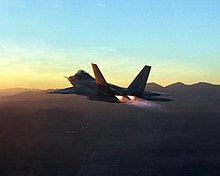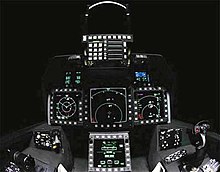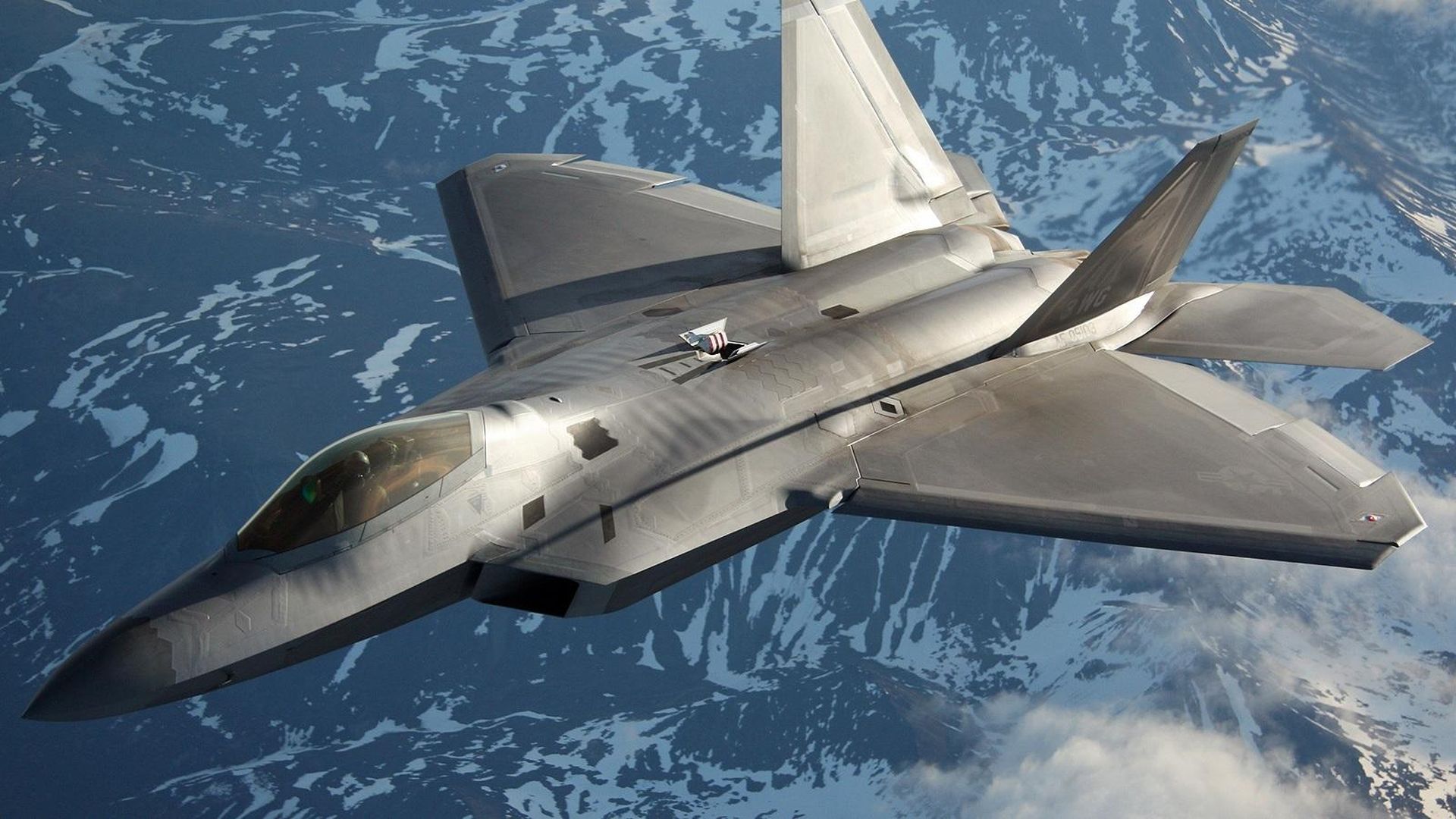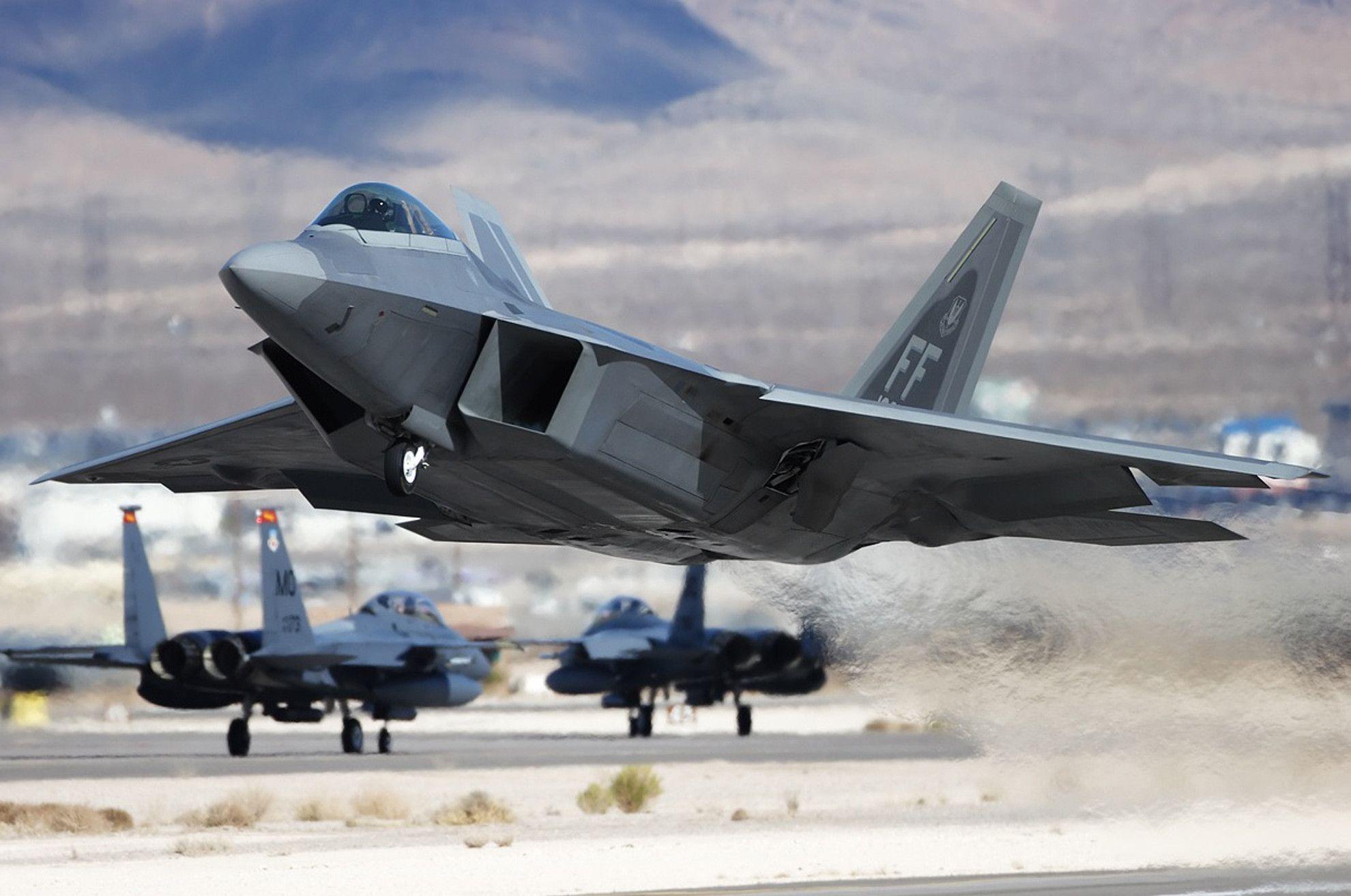Specifications
General characteristics -
- Crew:
1 - Length:
62 ft 1 in (18.92 m) -
Wingspan:
44 ft 6 in (13.56 m) - Height:
16 ft 8 in (5.08 m) - Wing
area:
840 sq ft (78.04 m2) - Aspect ratio:
2.36 - Airfoil:
NACA 6 series airfoil - Empty weight:
43,340 lb (19,700 kg) - Gross weight:
64,840 lb (29,410 kg) - Max takeoff weight:
83,500 lb (38,000 kg) - Fuel capacity:
18,000 lb (8,200 kg) internally, or 26,000 lb (12,000 kg) with two 2× 600 US gal tanks - Powerplant:
2 × Pratt & Whitney F119-PW-100 augmented turbofans, 26,000 lbf (116 kN) thrust each dry, 35,000 lbf (156 kN) with afterburner
Performance -
- Maximum speed:
Mach 2.25 (1,500 mph, 2,414 km/h) at altitude
-
Mach 1.21, 800 knots (921 mph; 1,482 km/h) at sea level -
1.82 (1,220 mph, 1,963 km/h) supercruise at altitude
-
-
Range:
1,600 nmi (1,800 mi, 3,000 km) or more with 2 external fuel tanks - Combat range:
460 nmi (530 mi, 850 km) clean with 100 nmi (115 mi, 185 km) in supercruise-
590 nmi (679 mi, 1,093 km) clean subsonic
-
- Ferry range:
1,740 nmi (2,000 mi, 3,220 km) - Service ceiling:
65,000 ft (20,000 m) - g limits:
+9.0/−3.0 - Wing loading:
77.2 lb/sq ft (377 kg/m2) - Thrust/weight:
1.08 (1.25 with loaded weight and 50% internal fuel)
Armament-
- Guns:
1× 20 mm (0.787 in) M61A2 Vulcan rotary cannon, 480 rounds -
Hardpoint:
4× under-wing pylon stations can be fitted to carry 600 U.S. gallon (2,270 L) drop tanks or weapons, each with a capacity of 5,000 lb (2,270 kg). - Air-to-air mission loadout:
-
6× AIM-120 AMRAAM -
2× AIM-9 Sidewinder
-
- Air-to-ground mission loadout:
-
2× 1,000 lb (450 kg) JDAM or 8× 250 lb (110 kg) GBU-39 Small Diameter Bombs -
2× AIM-120 AMRAAM -
2× AIM-9 Sidewinder
-
Avionics -
-
AN/APG-77 or AN/APG-77(V)1 radar: 125–150 miles (201–241 km) against 1 m2 (11 sq ft) targets (estimated range), 250 miles (400 km) in narrow beams -
AN/AAR-56 Missile Launch Detector (MLD) -
AN/ALR-94 radar warning receiver (RWR): 250 nautical miles (460 km) or more detection range Integrated CNI Avionics-
/40 flares for protection against IR missiles
The Lockheed Martin F-22 Raptor is an American single-seat, twin-engine, all-weather stealth tactical fighter aircraft developed for the United States Air Force (USAF). The result of the USAF's Advanced Tactical Fighter (ATF) program, the aircraft was designed primarily as an air superiority fighter, but also has ground attack, electronic warfare, and signal intelligence capabilities. The prime contractor, Lockheed Martin, built most of the F-22's airframe and weapons systems and conducted final assembly, while Boeing provided the wings, aft fuselage, avionics integration, and training systems. The aircraft was variously designated F-22 and F/A-22 before it formally entered service in December 2005 as the F-22A. Despite its protracted development and various operational issues, USAF considers the F-22 a critical component of its tactical airpower. The fighter’s combination of stealth, aerodynamic performance, and avionics systems enable unprecedented air combat capabilities. The USAF had originally planned to buy a total of 750 ATFs. In 2009, the program was cut to 187 operational aircraft due to high costs, a lack of clear air-to-air missions due to delays in Russian and Chinese fighter programs, a ban on exports, and development of the more versatile F-35.[N 1] The last F-22 was delivered in 2012. The Next Generation Air Dominance (NGAD) fighter system is expected to be a successor to the F-22.
Overview

An F-22 releases a flare during a training flight
The F-22 Raptor is a fifth-generation fighter that is considered fourth generation in stealth aircraft technology by the USAF. It is the first operational aircraft to combine supercruise, supermaneuverability, stealth, and sensor fusion in a single weapons platform.The F-22 has four empennage surfaces, retractable tricycle landing gear, and clipped delta wings with reverse trailing edge sweep and leading edge extensions running to the upper outboard corner of the inlets. Flight control surfaces include leading-edge flaps, flaperons, ailerons, rudders on the canted vertical stabilizers, and all-moving horizontal tails (stabilators); for speed brake function, the ailerons deflect up, flaperons down, and rudders outwards to increase drag. The aircraft's dual Pratt & Whitney F119-PW-100 augmented turbofan engines are closely spaced and incorporate pitch-axis thrust vectoring nozzles with a range of ±20 degrees; each engine has maximum thrust in the 35,000 lbf (156 kN) class. The F-22's thrust-to-weight ratio at typical combat weight is nearly at unity in maximum military power and 1.25 in full afterburner. Maximum speed without external stores is approximately Mach 1.8 at military power and greater than Mach 2 with afterburners.
The F-22's high cruise speed and operating altitude over prior fighters improve the effectiveness of its sensors and weapon systems, and increase survivability against ground defenses such as surface-to-air missiles.The ability to supercruise, or sustain supersonic flight without using afterburners, allows it to intercept targets which subsonic aircraft would lack the speed to pursue and afterburner-dependent aircraft would lack the fuel to reach. The F-22's thrust and aerodynamics enable regular combat speeds of Mach 1.5 at 50,000 feet (15,000 m).The use of internal weapons bays permits the aircraft to maintain comparatively higher performance over most other combat-configured fighters due to a lack of parasitic drag from external stores. The airplane's structure contains a significant amount of high-strength materials to withstand stress and heat of sustained supersonic flight. Respectively, titanium alloys and composites comprise 39% and 24% of the structural weight. The F-22's aerodynamics, relaxed stability, and powerful thrust-vectoring engines give it excellent maneuverability and energy potential across its flight envelope. The airplane has excellent high alpha (angle of attack) characteristics, capable of flying at trimmed alpha of over 60° while maintaining roll control and performing maneuvers such as the Herbst maneuver (J-turn) and Pugachev's Cobra. The flight control system and full-authority digital engine control (FADEC) make the aircraft highly departure resistant and controllable, thus giving the pilot carefree handling.
Avionics

An F-22 releases a flare during a training flight
The aircraft has an integrated avionics system where through sensor fusion, data from the radar, other sensors, and external systems are filtered and combined into a common view, thus enhancing the pilot's situational awareness and reducing workload. Key systems include Sanders/General Electric AN/ALR-94 electronic warfare system, Lockheed Martin AN/AAR-56 infrared and ultraviolet Missile Launch Detector (MLD), Westinghouse/Texas Instruments AN/APG-77 active electronically scanned array (AESA) radar, and TRW Communication/Navigation/Identification (CNI) suite. The MLD uses six sensors to provide full spherical infrared coverage.[109] Among the most technically complex equipment on the airplane is the ALR-94 system, a passive radar detector with more than 30 antennas blended into the wings and fuselage for all-round radar warning receiver (RWR) coverage. Its range (250+ nmi) exceeds the radar's and can cue radar emissions to be confined to a narrow beam (down to 2° by 2° in azimuth and elevation) to increase stealth. Depending on the detected threat, the defensive systems can prompt the pilot to release countermeasures such as flares or chaff. The ALR-94 can be used as a passive detection system capable of searching targets and providing enough information for a radar lock on. Tactical communication between F-22s is performed using the directional Inter/Intra-Flight Data Link (IFDL).
The APG-77 radar has a low-observable, active-aperture, electronically scanned antenna with multiple target track-while-scan in all weather conditions; radar emissions can also be focused to overload enemy sensors as an electronic-attack capability. The radar changes frequencies more than 1,000 times per second to lower interception probability and has an estimated range of 125–150 mi (201–241 km) against a 11 sq ft (1 m2) target and 250 mi (400 km) or more in narrow beams. An F-22 pilot noted that he was able to spot targets from beyond 320 miles away while flying with the AN/APG-77v1.F-22s from Lot 5 and on are equipped with the APG-77(V)1, which provides air-to-ground functionality through synthetic aperture radar mapping and various strike modes.Radar and CNI information are processed by two Hughes Common Integrated Processor (CIP)s, each capable of processing up to 10.5 billion instructions per second. The aircraft has also been upgraded to incorporate an automatic ground collision avoidance system (GCAS).
The F-22's ability to operate close to the battlefield gives the aircraft threat detection and identification capability comparative with the RC-135 Rivet Joint, and the ability to function as a "mini-AWACS", though its radar is less powerful than those of dedicated platforms. This allows the F-22 to rapidly designate targets for allies and coordinate friendly aircraft.Data can be transferred to other aircraft via Link 16 using the MIDS-J radio.The IEEE 1394B bus developed for the F-22 was derived from the commercial IEEE 1394 "FireWire" bus system.In 2007, the F-22's radar was tested as a wireless data transceiver, transmitting data at 548 megabits per second and receiving at gigabit speed, far faster than the Link 16 system.
The F-22's software has some 1.7 million lines of code, the majority involving processing radar data.Former Secretary of the USAF Michael Wynne blamed the use of the DoD's Ada for cost overruns and delays on many military projects, including the F-22. The integrated nature of avionics has also made upgrades challenging; consequently, open-system architecture for the aircraft is currently planned in order to facilitate future upgrades.
Cockpit

Cockpit of the F-22, showing instruments, head-up display and throttle top
The F-22 has a glass cockpit with all-digital flight instruments. The monochrome head-up display offers a wide field of view and serves as a primary flight instrument; information is also displayed upon six color liquid-crystal display (LCD) panels.The primary flight controls are a force-sensitive side-stick controller and a pair of throttles. The USAF initially wanted to implement direct voice input (DVI) controls, but this was judged to be too technically risky and was abandoned. The canopy's dimensions are approximately 140 inches long, 45 inches wide, and 27 inches tall (355 cm × 115 cm × 69 cm) and weighs 360 pounds. The canopy was redesigned after the original design lasted an average of 331 hours instead of the required 800 hours.
The F-22 has integrated radio functionality, the signal processing systems are virtualized rather than as a separate hardware module. The integrated control panel (ICP) is a keypad system for entering communications, navigation, and autopilot data. Two 3 in × 4 in (7.6 cm × 10.2 cm) up-front displays located around the ICP are used to display integrated caution advisory/warning (ICAW) data, CNI data and also serve as the stand-by flight instrumentation group and fuel quantity indicator.[124] The stand-by flight group displays an artificial horizon, for basic instrument meteorological conditions. The 8 in × 8 in (20 cm × 20 cm) primary multi-function display (PMFD) is located under the ICP, and is used for navigation and situation assessment. Three 6.25 in × 6.25 in (15.9 cm × 15.9 cm) secondary multi-function displays are located around the PMFD for tactical information and stores management.
The ejection seat is a version of the ACES II commonly used in USAF aircraft, with a center-mounted ejection control. The F-22 has a complex life support system, which includes the onboard oxygen generation system (OBOGS), protective pilot garments, and a breathing regulator/anti-g (BRAG) valve controlling flow and pressure to the pilot's mask and garments. The pilot garments were developed under the Advanced Technology Anti-G Suit (ATAGS) project and protect against chemical/biological hazards and cold-water immersion, counter g-forces and low pressure at high altitudes, and provide thermal relief. Following a series of hypoxia-related issues, the life support system was revised to include an automatic backup oxygen system and a new flight vest valve.
Armament

One AIM-120 AMRAAM (right) and four GBU-39 SDB (left) fitted in the main weapons bay of an F-22
The F-22 has three internal weapons bays: a large main bay on the bottom of the fuselage, and two smaller bays on the sides of the fuselage, aft of the engine intakes.The main bay is split along the centerline and can accommodate six LAU-142/A launchers for beyond-visual-range missiles and each side bay has an LAU-141/A launcher for short-range missiles. Four of the launchers in the main bay can be replaced with two bomb racks that can each carry one 1,000 lb (450 kg) or four 250 lb (110 kg) bombs. Carrying armaments internally maintains the aircraft's stealth and minimizes additional drag. Missile launches require the bay doors to be open for less than a second, during which pneumatic or hydraulic arms push missiles clear of the aircraft; this is to reduce vulnerability to detection and to deploy missiles during high-speed flight.
The F-22 can carry air-to-surface weapons such as bombs with JDAM guidance and the Small Diameter Bomb, but cannot self-designate for laser-guided weapons. Internal air-to-surface ordnance is limited to 2,000 lb (910 kg). An internally mounted M61A2 Vulcan 20 mm rotary cannon is embedded in the airplane's right wing root with the muzzle covered by a retractable door to maintain stealth. The radar projection of the cannon fire's path is displayed on the pilot's head-up display
The F-22's high cruise speed and altitude increase the effective ranges of its munitions, with the aircraft having 50% greater employment range for the AIM-120 AMRAAM and twice the effective range for JDAMs than prior platforms. In testing, an F-22 dropped a GBU-32 JDAM from 50,000 feet (15,000 m) while cruising at Mach 1.5, striking a moving target 24 miles (39 km) away. While the F-22 typically carries weapons internally, the wings include four hardpoints, each rated to handle 5,000 lb (2,300 kg). Each hardpoint can accommodate a pylon that can carry a detachable 600-gallon (2,270 L) external fuel tank or a launcher holding two air-to-air missiles; the two inboard hardpoints are "plumbed" for external fuel tanks. The use of external stores degrades the aircraft's stealth and kinematic performance; after releasing stores the external attachments can be jettisoned to restore those characteristics. A stealthy ordnance pod and pylon was being developed to carry additional weapons in the mid-2000s.
Stealth

For stealth, the F-22 carries weapons in internal bays. The doors for the center and side bays are open; the six LAU-142/A AMRAAM Vertical Eject Launchers (AVEL) are visible.
he F-22 was designed to be highly difficult to detect and track by radar. Measures to reduce RCS include airframe shaping such as alignment of edges, fixed-geometry serpentine inlets and curved vanes that prevent line-of-sight of the engine faces and turbines from any exterior view, use of radar-absorbent material (RAM), and attention to detail such as hinges and pilot helmets that could provide a radar return. The F-22 was also designed to have decreased radio emissions, infrared signature and acoustic signature as well as reduced visibility to the naked eye. The aircraft's flat thrust-vectoring nozzles reduce infrared emissions of the exhaust plume to mitigate the threat of infrared homing ("heat seeking") surface-to-air or air-to-air missiles. Additional measures to reduce the infrared signature include special topcoat and active cooling of leading edges to manage the heat buildup from supersonic flight.
Compared to previous stealth designs like the F-117, the F-22 is less reliant on RAM, which are maintenance-intensive and susceptible to adverse weather conditions. Unlike the B-2, which requires climate-controlled hangars, the F-22 can undergo repairs on the flight line or in a normal hangar. The F-22 has a Signature Assessment System which delivers warnings when the radar signature is degraded and necessitates repair. While the F-22's exact RCS is classified, in 2009 Lockheed Martin released information indicating that from certain angles the airplane has an RCS of 0.0001 m2 or −40 dBsm – equivalent to the radar reflection of a "steel marble"; the aircraft can mount a Luneburg lens reflector to mask its RCS. Effectively maintaining the stealth features can decrease the F-22's mission capable rate to 62–70%
The effectiveness of the stealth characteristics is difficult to gauge. The RCS value is a restrictive measurement of the aircraft's frontal or side area from the perspective of a static radar. When an aircraft maneuvers it exposes a completely different set of angles and surface area, potentially increasing radar observability. Furthermore, the F-22's stealth contouring and radar-absorbent materials are chiefly effective against high-frequency radars, usually found on other aircraft. The effects of Rayleigh scattering and resonance mean that low-frequency radars such as weather radars and early-warning radars are more likely to detect the F-22 due to its physical size. However, such radars are also conspicuous, susceptible to clutter, and have low precision. Additionally, while faint or fleeting radar contacts make defenders aware that a stealth aircraft is present, reliably vectoring interception to attack the aircraft is much more challenging. According to the USAF an F-22 surprised an Iranian F-4 Phantom II that was attempting to intercept an American UAV, despite Iran's assertion of having military VHF radar coverage over the Persian Gulf.


